SWOT at Your Next Virtual All-Hands

A Strengths, Weaknesses, Opportunities and Threats analysis can be an effective tool for highlighting shared experiences and identifying opportunities for progress. Conducting a SWOT does not have to be reserved for siloed initiatives or C-suites.
Setting aside time for both self-reflection and shared reflection helps individuals and entire organizations align. Recently, we leveraged a SWOT analysis to do just that during a company-wide virtual all-hands retreat. You can, too. Follow these steps!
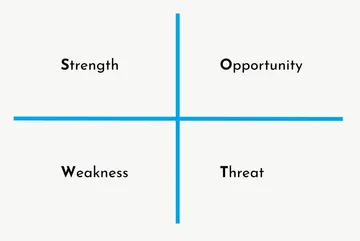
Prep
2-3 weeks in advance:
- Know your purpose. For our team, we wanted to prompt reflection and shared understanding.
- Collect your SWOT data via a staff-wide survey 3 weeks before your event. Collecting data in advance will give you time to review and reflect on the insights.
- Align your questions with the four different quadrants of SWOT. Here are the questions we used:
- What are [your organization]’s key strengths?
- What are [your organization]’s key weaknesses?
- What are the most valuable opportunities that [your organization] should pursue?
- What threats or challenges might compromise progress at [your organization]?
1 week in advance:
- Close survey.
- Organize responses using a collaborative tool like a FigJam board. It was important to us that our entire team had access to all (anonymized) responses, so we kept all of the data (including duplicate responses).
- Group similar/duplicate responses together to highlight and represent the volume of responses.
Breakout Session
The session is broken up into 3 parts. Start by getting acquainted with the tool and goals of the session. Next, focus inward on self-reflection to help individuals see themselves as a part of the larger organizational puzzle. Finish with breaking out into small groups and focusing on opportunities and next steps. Small groups will workshop how to bring all of these ideas into actionable opportunities.
Part 1: Get Familiar with SWOT (5 minutes)
Spend some time with your participants orienting them to what a SWOT is, what your specific goals for the session are, and what they can expect from the session.
Before sharing the big SWOT, we shared a summarized version that highlighted the themes we saw in the survey responses by quadrant .
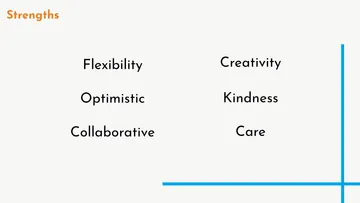
We asked everyone to jot down notes on what came to mind for each quadrant based on their own work experiences. How do you relate to these words?
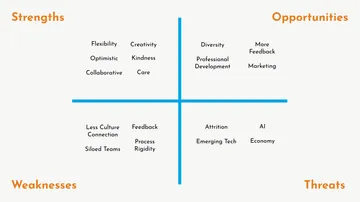
When we’d done this with all four quadrants, everyone had notes on how they could relate to all the themes, which made seeing the full SWOT board less overwhelming.
Part 2: Data Review & Guided Self Reflection (15 - 30 minutes)
Share the full, anonymous SWOT responses in your collaborative tool. You might choose a tool that allows your participants to upvote or comment for a more collaborative data review.
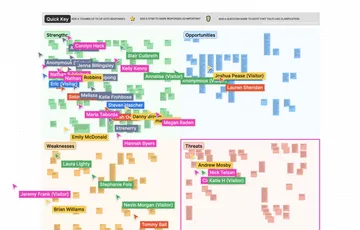
Before you do, explain that as everyone takes in the data, they should complete guided self-reflection prompts for each quadrant.
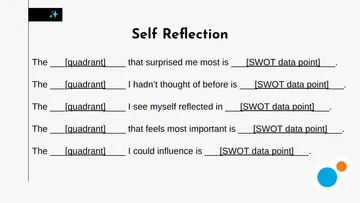
After 15 minutes of quiet jazz music and reflection, spend some time sharing back reflections and responses with the group. You might ask, "Who wants to share?" or be more specific with nudges like, "Let's hear about what surprised you most."
Part 3: Workshop Opportunities in Breakout Groups (15 - 30 minutes)
For the next part of the breakout session, shift gears to focus on opportunities and come up with ideas for actionable next steps.
This is the forward-thinking “dream big about your future” part of the breakout session.
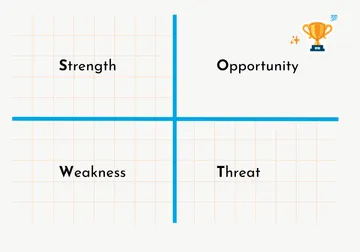
Share expectations and guidance, then break your participants up into small groups. We broke our team up into groups of 5.
Groups will:
Identify an opportunity to explore further. Using the self reflection from the earlier part of the session as a starting point, discuss what stood out most about SWOT opportunities.
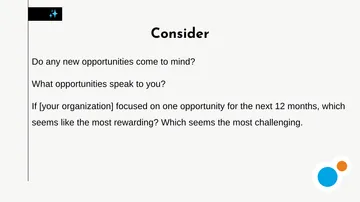
Identify next steps. Once groups have their opportunity, they’ll workshop how to bring it to life.
Encourage teams to imagine their chosen opportunity as an organization, team, or personal goal. Next, they need to narrow in and think big.
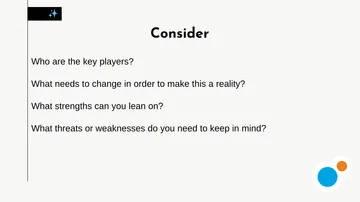
Before time was up, we asked our participants to capture their chosen opportunity and 3-5 next steps in a shared document, and be prepared to discuss as a larger group.
After 15-30 minutes of being in our breakout groups, we came back together and opened the floor for discussion.
My Reflection on Our Reflection
Our team spent 15 minutes working in breakout groups and working through the guided self-reflection. We spent 5 minutes sharing back. If I were to repeat this activity again, I would keep the self-reflection section the same and increase the allotted time for the opportunities workshop. We received feedback from groups that they wished they had more time to discuss opportunities and key next steps together.
This breakout session template worked for our team of 50 participants, but it can easily be scaled for teams of different sizes. For larger teams, you may opt to spend more time sharing insights back with the larger group or explore more than one opportunity during part 3 of the breakout.
We host TTTs every quarter, nearly all of them feature breakout sessions. We’ve learned that transparency, shared resources, and allowing time for groups to share back insights gained are crucial elements for a successful breakout session.
Regardless of your breakout session approach, we find that high performing teams regularly take time to reflect, align and reset. Doing so is critical for individual and business success.
